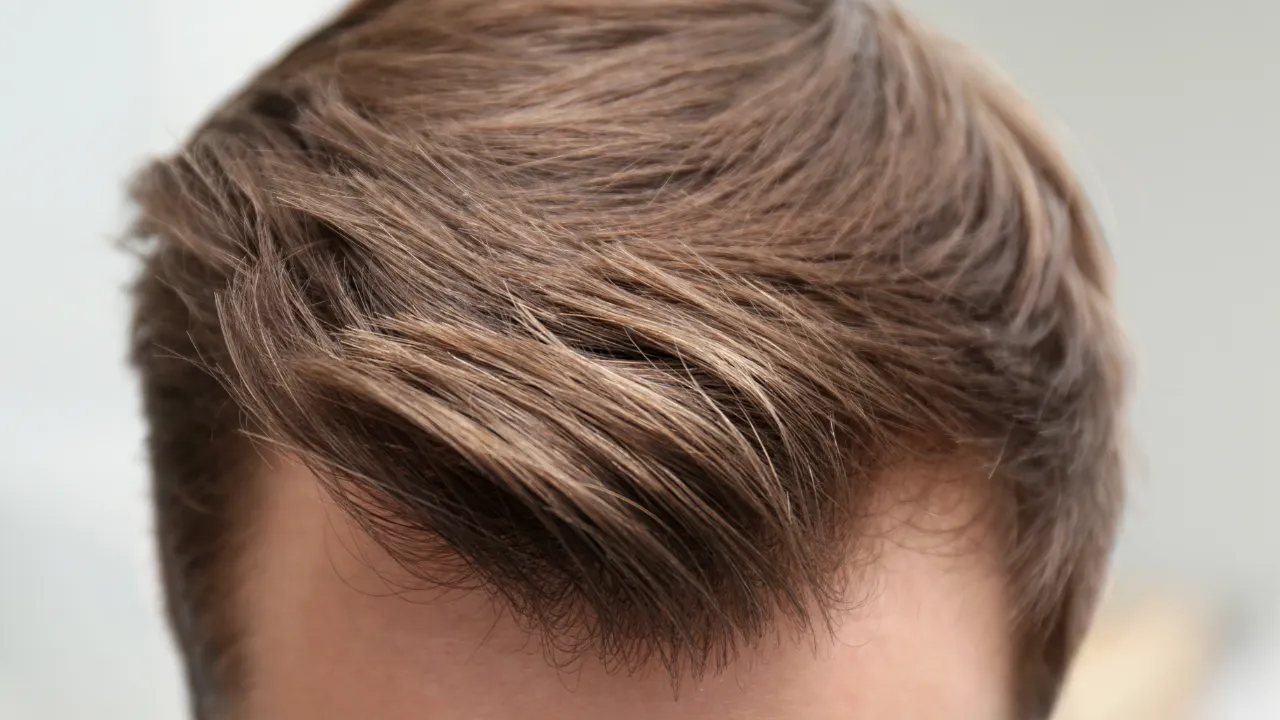Table of Contents
ToggleAt Kopelman Hair, we specialize in advanced hair restoration, helping you regain confidence and a youthful look. Our expertise includes treating conditions like alopecia barbae and alopecia beard, two forms of facial hair loss that cause bald spots in the beard area.
This guide explains the causes and symptoms of alopecia barbae. It also offers effective treatment options. This will help you make informed choices about your hair restoration journey.
What Is Alopecia Barbae?
Alopecia barbae is a form of alopecia areata beard, an autoimmune disorder where the immune system mistakenly attacks healthy hair follicles. This causes smooth, round bald spots in the beard area. While not life-threatening, it can significantly affect self-esteem.
Understanding Beard Alopecia and Hair Loss
Beard alopecia causes patchy, well-defined hair loss in the beard. Unlike general thinning, it creates smooth, hairless areas that may expand. In some cases, hair regrowth occurs, but the new hair can appear thinner or lighter.
Because alopecia areata barbae stems from immune dysregulation, stress and genetics can make alopecia barbae regrowth slower without early treatment.
This condition shares traits with scalp alopecia and often links to an autoimmune condition. For some, treatments like hair transplants may also be considered when hair loss becomes extensive or persistent.
How Rare Is Alopecia Barbae?
Alopecia barbae is less common than other forms of hair loss. It affects a small subset of adults, mostly men. Although rare, its emotional impact can be significant.
- Around 2% of people experience some form of alopecia areata.
- Beard-specific cases are far less frequent.
If you notice sudden hair loss in your beard area, early consultation with our hair transplant experts can provide answers and solutions.
What Causes Alopecia Barbae?
The exact cause of alopecia barbae remains unclear, but key triggers include:
- Stress: Emotional or physical stress can activate immune responses.
- Genetics: A family history of autoimmune diseases increases risk.
- Environmental Factors: Allergens or irritants may play a role.
- Hormonal Imbalances: Conditions like thyroid disorders impact facial hair health
Is It Linked to Autoimmune Conditions?
Yes, alopecia barbae is closely tied to autoimmune disorders where the immune system targets hair follicles. Common related conditions include:
- Vitiligo: Loss of skin pigmentation.
- Thyroid Disorders: Hormonal imbalances.
- Alopecia Totalis: Complete scalp hair loss.
Monitoring for underlying autoimmune issues through a blood test is essential to rule out related health concerns. When coupled with treatments like hair transplants, tailored care plans can improve long-term outcomes for those experiencing alopecia facial hair loss.
Other Causes of Alopecia in Beard and Treatments
While alopecia barbae and naturally sparse facial hair are the main culprits, other conditions can also cause beard bald patches:
1. Beard Ringworm (Tinea Barbae)

- Cause: A fungal infection often transmitted from animals or infected individuals.
- Symptoms: Red, inflamed circular rash, sometimes with pus, crusting, tenderness, and itchiness; localized beard hair loss, potentially permanent with severe infections.
- Treatment: Antifungal shampoos (e.g., ketoconazole, selenium sulfide) and systemic antifungal medications (e.g., griseofulvin, itraconazole, fluconazole).
2. Psoriasis

- Cause: An autoimmune condition causing inflammation in the skin, including the beard area.
- Symptoms: Thick, red or pink plaques with silver flaking, itchiness, tenderness, and temporary hair loss during flare-ups.
- Treatment: No permanent cure exists, but steroid creams or injections can reduce inflammation, discomfort, and hair loss.
3. Seborrheic Dermatitis

- Cause: Overgrowth of Malassezia furfur fungus leading to inflammation and hair breakage from excessive scratching. For more information, take a look at our recent article on Beard Dandruff Cure: How to Get Rid of Flakes.
- Symptoms: Greasy white or yellow flakes, reddish inflamed skin, itchiness, and tenderness.
- Treatment: Medicated shampoos (e.g., ketoconazole, coal tar, salicylic acid, selenium sulfide); systemic antifungal medications if severe.
Is Alopecia Barbae Dangerous?
Alopecia barbae is not medically dangerous. However, it can cause emotional distress, impacting confidence and daily life. Addressing both physical and psychological aspects is crucial for overall well-being.
Symptoms of Alopecia Barbae
The most obvious symptoms of alopecia barbae are:
- Bald Spots: Smooth, round patches in the beard area.
- Hair Thinning: Hair around the patches may weaken and fall out.
- Skin Changes: The affected area may feel smooth or slightly itchy.
- Exclamation Mark Hairs: Short, broken hairs near the edges of bald patches.
In severe cases, facial alopecia can spread to other areas, like the scalp or eyebrows.
How Do You Treat Alopecia Barbae?
Medical Treatments for Beard Alopecia
Effective options for treating alopecia barbae include:
- Topical Steroids: Reduces inflammation in the affected area.
- Corticosteroid Injections: Targets specific bald spots to suppress immune responses.
- Minoxidil (Rogaine): Stimulates hair follicles for regrowth.
- JAK Inhibitors: Oral or topical medications that regulate immune activity.
- Immunotherapy: Treatments like DPCP retrain the immune system to stop attacking hair.
For those with persistent hair loss, hair transplants can restore natural-looking facial hair by relocating healthy follicles to the affected areas. Consult specialists at Kopelman Hair for personalized treatment plans with minimal side effects.
Natural Remedies and Lifestyle Adjustments
Complement medical treatments with these natural strategies:
- Manage Stress: Use meditation, exercise, or adequate sleep to reduce immune overactivity.
- Nutrient-Rich Diet: Vitamins like Biotin and D, and minerals like zinc, support hair health.
- Gentle Beard Care: Use mild cleansers and avoid harsh grooming products.
- Essential Oils: Oils like rosemary may stimulate follicles and promote regrowth. For a closer look, check out our comprehensive article on Oil for Hair Growth.
Alopecia Barbae Recovery Time
Recovery time depends on severity and treatment:
- Mild Cases: Hair may regrow within 3-6 months.
- Moderate Cases: Noticeable improvement takes 6-12 months.
- Severe Cases: Extensive hair loss may require ongoing treatment.
With professional care from Kopelman Hair, your chances of full recovery improve significantly.
How Is Alopecia Barbae Diagnosed?
Diagnosing alopecia barbae involves a few simple steps:
- Visual Examination: Identify the characteristic bald spots in the beard.
- Medical History: Review family history, lifestyle, and stress factors.
- Skin Biopsy: Rule out other conditions by examining a sample from the affected area.
- Blood Test: Check for thyroid imbalances or autoimmune markers.
Accurate diagnosis helps create the right treatment approach.
Can You Get SSI for Alopecia Barbae?
Eligibility for Disability Benefits
Qualifying for Supplemental Security Income (SSI) for alopecia barbae is challenging since it’s not usually considered disabling. However, you may qualify if:
- It significantly affects your ability to work.
- It’s linked to a severe autoimmune disease that meets SSI criteria.
Proper medical documentation is essential to strengthen your claim.
Coping with Beard Hair Loss
Psychological Impact of Alopecia Barbae
Losing facial hair can be emotionally challenging. Many men feel a loss of identity, confidence, or increased anxiety in social situations. Acknowledging these feelings and seeking support from professionals or loved ones can make a big difference.
Tips for Managing Facial Hair Loss
Here are practical tips to manage beard hair loss:
- Experiment with Grooming: Trim your beard for an even look or shave for a clean appearance.
- Use Cosmetic Solutions: Beard fillers or tinted powders can conceal bald patches temporarily.
- Join Support Groups: Sharing experiences with others can help reduce emotional stress.
- Focus on Health: A balanced diet and regular exercise support hair and overall well-being.
Taking control of your situation helps restore confidence as you explore treatment options.
FAQs About Alopecia Barbae
Can Alopecia Barbae Regrow on Its Own?
Yes, in some cases, hair regrowth occurs naturally. However, it can be unpredictable, and the new hair may initially appear thinner or lighter.
How Long Does Recovery Take?
- Mild Cases: 3-6 months with proper care.
- Moderate to Severe Cases: 6-12 months or longer, depending on treatment adherence.
Consistency with treatments improves recovery outcomes.
Can It Spread to Other Areas?
Yes, facial alopecia may progress to other parts of the body, including the scalp (alopecia totalis), eyebrows, or other facial regions. Monitoring symptoms and seeking timely treatment can help control its spread.
Our Final Thoughts
At Kopelman Hair, we provide expert care for conditions like alopecia barbae. From diagnosing the cause to offering tailored treatments, we ensure you receive the best solutions to restore your beard and confidence. Don’t let facial hair loss hold you back—schedule a consultation today and take the first step toward regrowth.
























